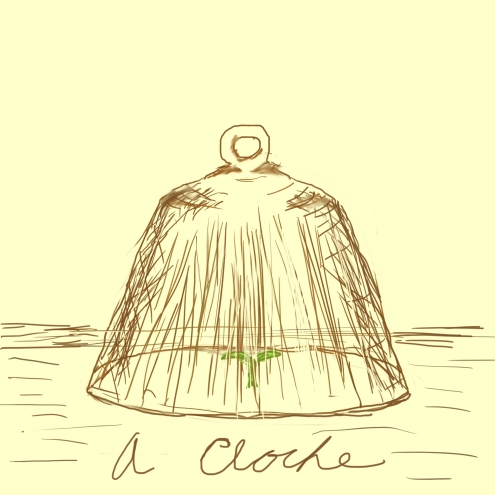Do you like the feel of a wooden handle? The weight of a well-crafted tool?
I know I do.
It’s time to rummage in the shed and dust off those tools whether you are looking forward to the spring thaw or are preparing your garden for winter. Here in Perth, I do all my gardening from autumn to spring as summer gardening is just too disheartening.
Here are 5 Handy Tools from the Victorian shed
1.The Cloche
On first seeing this word I thought it was perhaps french for clock, maybe some sort of sundial?
It is French, French for bell, as in a bell shaped glass to ward off frost from tender young plants and extend the growing season in chilly climates.
Presumably, cloches used to all be bell shaped but by the Victorian age many looked like glass lanterns with wooden or metal frames and panes of glass. They range in size from small enough to be carried in one hand for the protection of a single young plant to large enough to pass for a portable greenhouse requiring two persons to move it.
Most of the tools we use in the garden today are variations on those that have been around since the middle ages.
2. The billhook
I had a vague idea this was a tool used in butchering animals, another erroneous conclusion.
The billhook is a cross between a machete and a butter knife, the fat rounded type of butterknife. It has a hook-shaped blade, with the sharp edge on the inside curve.
It is a tool of precision for pruning, shaping decorative hedges and grafting. However it can be a weapon of mass destruction in the hands of an enthusiastic novice gardener, both to the plants and the gardener,
It should always be kept sharp, dry and out of the reach of children and novices.
3. The Dibbler
I want one of these just so I can say, “Pass me the dibbler love.”
A perfectly formed wooden instrument worn smooth from years of frequent use or a metal handle and wooden spike, a dibbler looks like the top of a shovel sawn off, its tip whittled to a rounded point for the purpose of making holes for seed.
Essentially it is a large substitute finger to save strain on your own digits.
4. the Daisy Grubber
Daisy grubber is so much more concise than my long-tail name for it. It is for getting the daisies out of your lawn by the roots with minimal damage to the lawn.
The metal loop at the back is for leverage. For obvious reasons, these are still immensely popular today and can be found at any gardening store.
5. the Mattock
I have heard the word mattock but did not know what it was.
It has a pick on one end and a cutting tool on the other. In my family, we call it a pick-ax.
You need a mattock for preparing a new garden bed, digging out a square of lawn or making a trench for drainage and reticulation. The only time I’ve used one was for digging a trench to lay down new plumbing.
They come in a variety of sizes, some measure a meter long and weigh several kilos requiring the strength of a well-built man to even lift let alone swing. Others are of more modest, manageable proportions suitable to the rest of us.
Helen in the Garden
All of these would have been new but indispensable tools, to Helen Kerr when she first arrived at Hamilton Hill for her summer as an under gardener. Personally, I’d keep her away from the billhook and give her a wide berth if swinging a mattock.
To read about Helen’s adventure from print shop to garden shed click here for Kindle and here for Kobo
For more information on the history of gardens and gardening see The History of the Garden in Fifty Tools by Bill Laws
a Note on the artwork
The pictures of the cloche, the billhook and the dibbler I sketched on my Wacom tablet, trying to get the hang of computer drawing. Then we moved house and I put the Wacom somewhere very safe and cannot locate it so the daisy grubber and mattock were sketched on ordinary A5 paper with colour pencils and scanned.
I haven’t picked up a sketch pad in years so beg your patience as I flex my illustrating muscles and try to work them back into shape.
What is your favourite garden tool or word?
leave a comment here or on twitter @SeahAmber.





I’m very impressed with your artistic abilities Amber! They matched the tool descriptions perfectly (most of which can be found in our shed…), so it was lovely to read that you drew them yourself.
LikeLike
Thank you Marie. I was inspired by Tania McCartney’s interview in episode 150 ‘So You Want to be a Writer’. I’m not committing to an illustration a week but I will be doing some illustration and photography for my blog.
LikeLiked by 1 person
I think that’s a great idea! It’s something unique that showcases your talent.
LikeLike